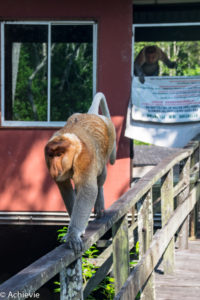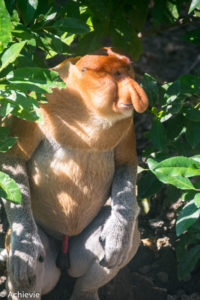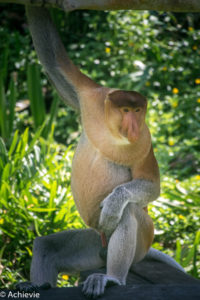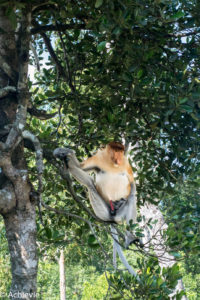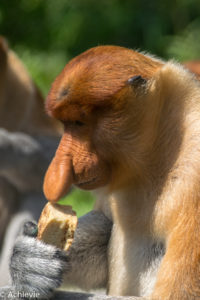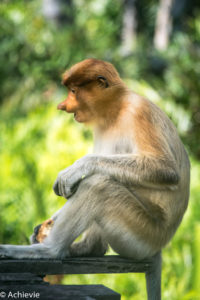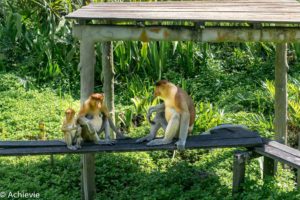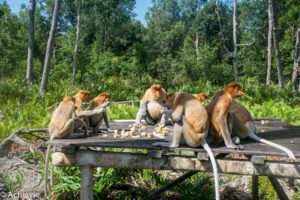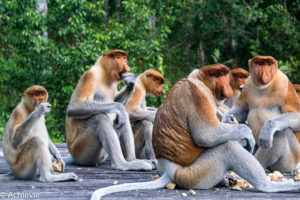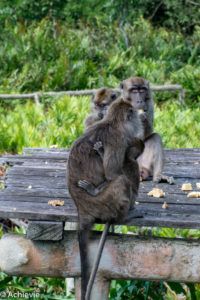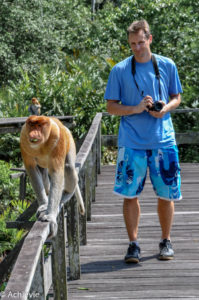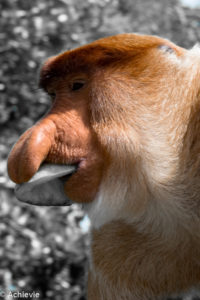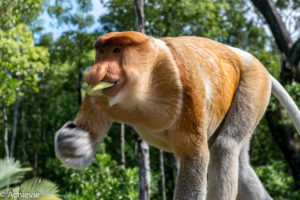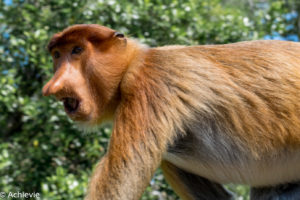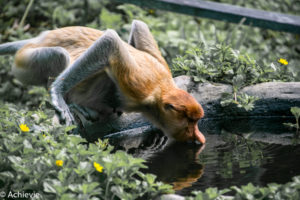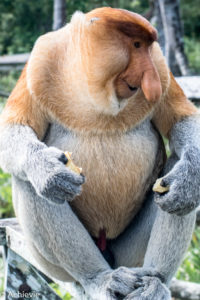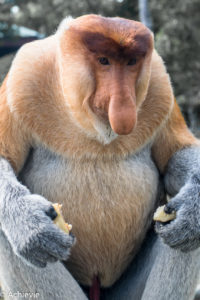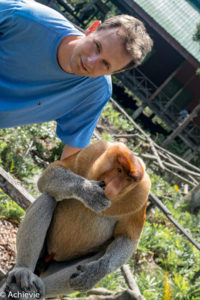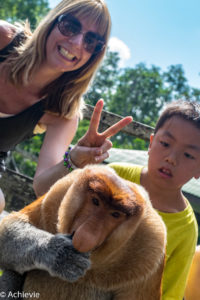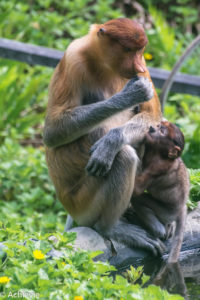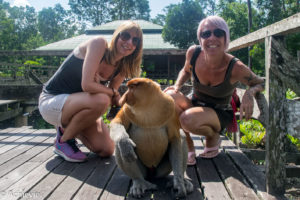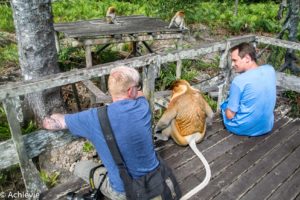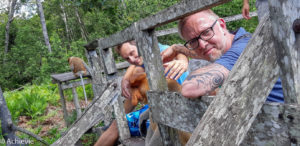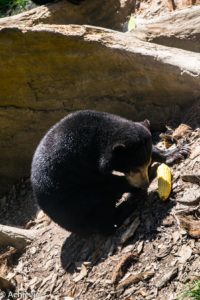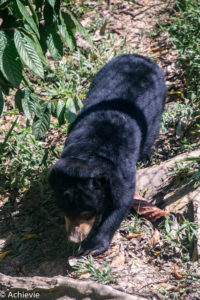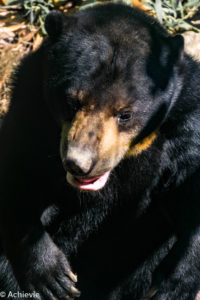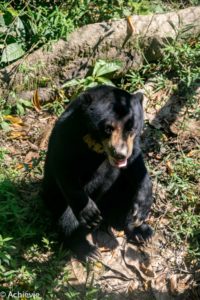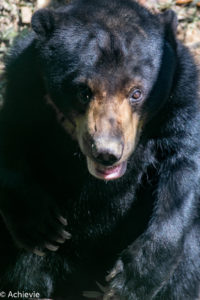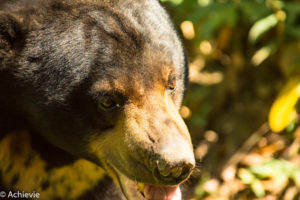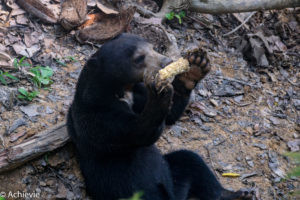Labuk Bay Proboscis Monkey Sanctuary
The Sanctuary is located at the center of the mangrove forest near Samawang Village at Labuk Bay, Sandakan, Sabah, Malaysia. It opens daily at 8am and closes at 6pm. The entrance fee for tourists is RM60 for adults and RM30 for children, plus RM10 per camera.
The proboscis monkey with its large pot belly is only to be found in certain parts of Borneo. We were lucky to see one in Bako National Park in Sarawak earlier on our vacation, but were anxious to see more of them in this sanctuary.
The sanctuary is privately owned and was first set-up in 1994 with the aim to help the proboscis monkey from losing its natural habitat because of deforestation. Next to the natural food sources, the monkeys’ diet is supplemented with fruits and water on a daily basis, from 2 observation platforms in the centre. This has led many groups of them to visit regularly to get a free meal.
It’s of course a good thing that these animals are being protected from the threats they are facing in the wild and at the same time it gives everyone the chance to see these great monkeys up close. On the other hand, you could question the real aim of this undertaking (exploiting these animals for tourists?) and the fact that tourists can come really close to them. While at Sepilok a lot of staff was keeping an eye on visitors not trespassing and coming too close to the wild animals, this was less the case here.
We did keep our distance of course and just enjoyed these funny creatures doing their thing. We were actually welcomed by a few males running into our direction as we were entering the area. They were storming right at us and we didn’t really know what to think in first instance, because of the speed and the noise they made. But we didn’t have anything to worry about. Our guide Joe explained that they were just boys showing off and wanting to appear the toughest.
There are indeed a few troops living here – each male with its own harem. Leaping from tree to tree in a well thought-out, stylish way. And the noise they make from time to time (mostly during eating) – so particular and funny! When one of them starts, it causes a chain reaction amongst the group as the noise spreads… unique, really. Apparently their large noses have something to do with it.
There’re 2 observation platforms – each has 2 feeding times a day. Platform A’s feeding is at 9.30 and 2.30, while the feedings on platform B are at 11.30 and 4.30.
A restaurant in the centre offers small meals and drinks.
Bornean Sun Bear Conservation Centre
The Bornean Sun Bear Conservation Centre is a sun bear rescue and rehabilitation facility in Sabah, about half an hour drive from the Labuk Bay Proboscis Monkey Sanctuary and right next to the Sepilok Orangutan Rehabilitation Centre.
Not familiar with the sun bear? It’s the smallest bear in the world as well as the least known one – only to be found in Southeast Asia. As with many specifies, its main threat is deforestation, poaching and illegal pet trade, where young cubs are taken to live as pets in unnatural conditions, with inadequate diets and no stimulation.
The more fortunate ones can be rescued and then they arrive at the centre, where they are offered a better life, living in large forest enclosures – their natural environment, until the rehabilitation is a success and they can go back to the wild – if that’s an option. Unfortunately, there are cases where bears cannot be released, as they are too traumatized. In that case the centre provides for a dignified permanent home. That’s what they’ve been doing since 2008, as a collaborative project between Sabah Forestry Department, Sabah Wildlife Department, Land Empowerment Animals People and Malaysian sun bear researcher Wong Siew Te. It’s actually the only sun bear conservation area in the world. Dr Wong Siew Te conducted the first ecological study of wild sun bears in Sabah’s rainforest and was attributed the CNN Heroes award, for his contribution and efforts for saving the sun bears. The purpose of the facility next to the rehabilitation, is increasing the protection of sun bears in their natural habitat and increasing the awareness of sun bears to the wider public.
When a new bear arrives, a health check is performed and the bear is put into quarantine for about a month to prevent diseases being spread. Although the bears are mainly solitary, they are introduced to other bears of a similar age, to encourage development. The expert researches and care takers help the bears to learn typical “bear behavior”. For cubs, the staff actually becomes their surrogate mothers, until they’re independent. They help them developing the skills needed, like climbing trees, nest building and self-defense. The bears are closely monitored to identify potential release, once they’re independent enough to take care of themselves.
But also the educational efforts the centre is taking are admirable. Promoting the awareness of sun bears and the threats they’re being faced is mostly needed locally – in rural communities, where animal welfare and conservation is often underdeveloped. Therefore schools are involved in the program.
Similar to what the Sepilok Orangutan Rehabilitation Centre offers, also in the Bornean Sun bear Conservation Centre you can adopt one of their cute furry inhabitants. There’s different options to choose from and a great way to help funding the activities of the facility.
